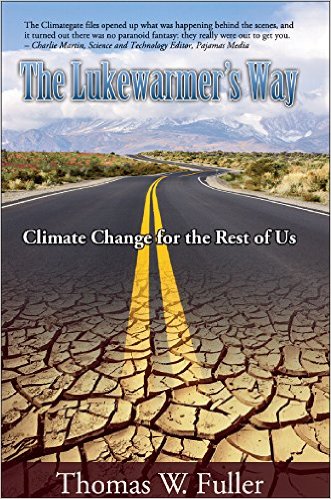Well, the first 24 hours were excellent for my new book “The Lukewarmer’s Way.” Expectations were high, given that the book I wrote with Steve Mosher 5 years ago (Climategate: The CRUTape Letters) was released in the middle of a media feeding frenzy about Climategate.
We didn’t sell as many copies on our first day with the new book, but we are now a very respectable #8 in books about weather on Kindle and #17 on books about ecology there. Still waiting for our first review, though, which isn’t good.
Here’s a teaser from the book:
As I have said throughout this book, I believe global warming is occurring and that we need to both address the causes and the effects. I’m also aware that the process of species loss occurs in slow motion, as well. Which is why it’s clear that anthropogenic climate change to date cannot be held responsible for large scale loss of species, because global warming is so recent in its inception. Scientists date the beginning of human-caused climate change to around 1945.
Meanwhile, the abandonment of scientific perspective by some Alarmists in order to join the crusade to climate Jerusalem gives tacit permission to continue to those who are causing the real damage via habitat loss, pollution, lax procedures that allow invasive species to be introduced inappropriately, and over-hunting.
Anthropogenic contributions to climate change are recent. Anthropogenic pressures on biodiversity have been going on for millenia. I have no doubt that we can chart many species already feeling additional pressure because of climate change. That’s a given, because that’s a constant. The climate always changes and it always puts pressure on vulnerable species. Anthropogenic climate change will do the same.
Global warming will have a negative effect on some species, perhaps many. Species loss is currently a real problem. The two facts don’t have much to do with each other.
My thoughts about preserving the biodiversity remaining on this planet are fairly simple:
- Policy that encourages urbanization density. Right now, over half the people on this planet live in cities that cover 3% of the land surface. This should be considered a good beginning, especially as most projected population growth is expected to be absorbed by the cities. However, given that only 2% of the population is required for modern agriculture, there should be room for improvement. Policies that make 3rd world cities more liveable, safe and sanitary can decrease pressure on the land.
- It is time to renegotiate the law of the sea. Let’s appoint conservators for individual fish species that have czar-like abilities to establish fishing regulations that keep the health of the fish paramount. Establish a multinational compensation fund that helps countries wean themselves off of their over-supplied and over-mechanized fishing fleets and just put them out of business slowly.
- Focus some element of scientific research on creating best practices and standards for sustainable fish farms. Create sustainable certification standards and labeling. Focus more on rewarding winners than punishing losers–many bad fish farm practices are the result of poverty more than anything else.
- Introduce best of breed agricultural practices to insure that needed agricultural product comes from better practices, not more land coming under the plough. Start at the geographic margins and work inwards, as it is at the margins that expansion of farms into new territory happens. Refine the food distribution system to reduce wastage, introduce GMOs liberally, etc.
If you want to protect other species, you must start by removing the need to harm them by improving the lot of the species that is threatening them. That would be us.
This Lukewarmer believes greenhouse gases may help cause temperatures to be about 2 degrees C warmer than otherwise would be the case, which will cause damage in many regions around the world. As it’s an average, some regions will be affected more than others.
Although this will not be a civilization buster (especially for the U.S.), we will be spending money–either to prepare for and so minimize some of the effects beforehand, or to fix some of the damage afterwards. The first of these two is easier and cheaper than the second.
Whatever you call Sandy, whether hurricane or tropical storm, you can look at it as something we will see more of in a warmer world. I don’t think Sandy was caused or strengthened much by current warming, but I think it’s currently an outlier that may look more normal in the future.
How close to the shore should we build? What offshore structures should we erect to soften storms’ impacts? How much cheaper are seawalls than extensive infrastructure repair? How does our current insurance system interact with public wishes and natural disasters to guide rebuilding?
We also might visit other societies impacted by storms at sea, from Japan to the Netherlands, to see if we can benchmark best practice.

